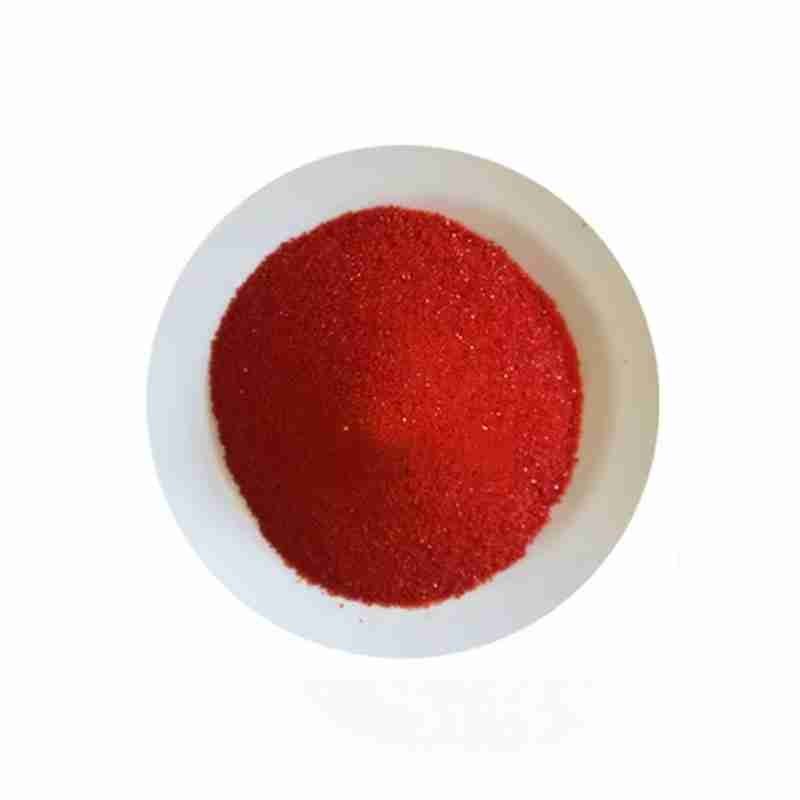Ferric Oxide CAS# 1309-37-1
Ferric oxide exists in nature in the form of hematite. It is the main iron ore for producing metals and their alloys. Moreover, this oxide exists in the mineral limonite 2Fe2O3 ?? 3H2O. One important application of this compound involves the production of red, orange, and yellow pigments. Other applications include coatings for metals, steel, and rubber; In the field of ceramics; And as a catalyst for oxidation reactions.
Ferric oxide is synthesized and mainly composed of anhydrous and/or hydrated iron oxide. The color range includes yellow, red, brown, and black. The main difference between food grade iron oxide and industrial grade iron oxide is that the pollution level of other metals is relatively low. This is achieved by selecting and controlling iron sources and/or the degree of chemical purification during the manufacturing process. Iron oxide has been used for coloring fillings and decorations in candies, pastry products, cheese products, fish sauce, pet food, cosmetics, and pharmaceuticals.
发送询盘
Ferric Oxide CAS# 1309-37-1
| Ferric oxide Basic information |
| Physical Properties?Occurrence and Uses?Preparation?Reactions |
| Product Name: | Ferric oxide |
| Synonyms: | Ferric oxide(II,III), magnetic nanoparticles solution;Ferric(III) oxide;Iron(III) oxide, 99% trace metals basis;Iron(III) oxide, 99.9% trace metals basis;Iron(III) oxide, 98% trace metals basis;Iron(III) oxide, 99.95% trace metals basis;Iron(III) oxide, 99.99% trace metals basis;Iron(lll) oxide |
| CAS: | 1309-37-1 |
| MF: | Fe2O3 |
| MW: | 159.69 |
| EINECS: | 215-168-2 |
| Product Categories: | Inorganics;metal oxide |
| Mol File: | 1309-37-1.mol |
 |
|
| Ferric oxide Chemical Properties |
| Melting point | 1538??C |
| density | 5.24 |
| Fp | >230???F |
| storage temp. | 2-8??C |
| solubility | It is soluble In Warm Hydrochloric Acid, Slightly Soluble in Sulfuric Acid. |
| form | pieces |
| color | black |
| Specific Gravity | 5.1??5.2 |
| PH | 3.7??0.3 |
| Water Solubility | INSOLUBLE |
| Merck | 14,4028 |
| Exposure limits | ACGIH: TWA 5 mg/m3 OSHA: TWA 10 mg/m3; TWA 15 mg/m3; TWA 5 mg/m3 NIOSH: IDLH 2500 mg/m3; TWA 5 mg/m3 |
| Stability: | Stable. |
| CAS DataBase Reference | 1309-37-1(CAS DataBase Reference) |
| IARC | 3 (Vol. 1, Sup 7) 1987 |
| NIST Chemistry Reference | Iron(iii) oxide(1309-37-1) |
| EPA Substance Registry System | Ferric oxide (1309-37-1) |
| Safety Information |
| Hazard Codes | Xi |
| Risk Statements | 36/37/38 |
| Safety Statements | 26 |
| OEB | B |
| OEL | TWA: 5 mg/m3 |
| WGK Germany | – |
| RTECS | NO7400000 |
| TSCA | Yes |
| HS Code | 28211000 |
| Hazardous Substances Data | 1309-37-1(Hazardous Substances Data) |
| IDLA | 2,500 mg Fe/m3 |
- 2
- 2-diallylpent-4-en-1-amine
- 4
- 95-16-9
- Ammonium sulfamate
- Benzothiazole
- cas:67889-00-3ح2
- cas:83524-75-8 | pigment black 32
- cas:928836-00-4 | 2
- cas:932745-70-5 | 4
- Chemical Minerals
- Coconut diethanolamide
- Daily Chemicals
- discount
- for sale
- General pvc resin
- hexyl D-glucoside
- in stock
- Lauramidopropyl betaine
- LAURIC ACID MONOETHANOLAMIDE
- Petroleum Additives
- Plasticiser
- Ploymers
- price
- PVC
- quotation
- Raw Materal
- Remove term: Petroleum Additives Petroleum Additive
- SODIUM ETHYL 2-SULFOLAURATE
Related Products
Chemical Name: Ammonium Iron(II) Sulfate
Synonyms: Diammonium iron bis(sulphate); iron (ii) ammonium sulfate
CAS No.: 10045-89-3
Molecular Formula: FeH5NO4S
Molecular Weight: 170.95
Chemical Name: STODDARD SOLVENT
CAS No.: 64742-88-7
Appearance: Colorless or Light Yellow Liquid
Product name:HYDROXYPROPYL GUAR HYDROXYPROPYLTRIMONIUM CHLORIDE
Purity:99%
Appearance:Light Yellow Powder
Package:Customized according to customer needs.
Sample:Available
Sodium aluminosilicate (CAS No.73987-94-7) is an inorganic compound.
It has a certain application in industry. For example, in the ceramic industry, sodium aluminosilicate can be used as a flux and an ingredient in ceramic glazes, helping to improve the performance and appearance of ceramics.
In some chemical processes, it may also function as a precipitating agent or an additive.
In the field of materials science, the properties and structural characteristics of sodium aluminosilicate make it have potential application value in the research and development of some new materials.
Aluminum chlorohydrate is an inorganic compound often used as a coagulant in water treatment processes. It is also known for its astringent properties and is utilized in various personal care products, such as antiperspirants and deodorants, due to its ability to temporarily close sweat glands. It enhances the viscosity and stability of formulations, making it a valuable ingredient in cosmetics and pharmaceuticals.
Chemical Name: 1,1,2,2-Tetrachloroethane
Other Name: Tetrachlorethane
CAS No.: 79-34-5
Molecular Formula: C2H2Cl4
Molecular Weight: 167.85
Appearance: Liquid
Chemical Name: Arabic gum
CAS No.: 9000-01-5
Appearance: powder
Chemical Name: Choline salicylate
CAS No.: 2016-36-6
Molecular Formula: C12H19NO4
Molecular Weight: 241.28
Appearance: Red-Brown Crystal
Chemical Name: Potassium Castorate
CAS No.: 8013-05-6
Molecular Formula: C57H107K3O12
Molecular Weight: 1101.74718
Appearance: Yellow Liquid
Calcium carbonate, with the chemical formula CaCO3, is an inorganic compound found in nature as calcite, aragonite, and vaterite. It is a white solid that is insoluble in water but soluble in acid. Widely used as a filler and coating pigment in paper and plastics, calcium carbonate also serves as a primary ingredient in the production of cement and lime. Known for its high purity and chemical stability, it is utilized in pharmaceuticals, food additives, and as a dietary calcium supplement. Its versatility makes it an essential component in various industrial applications.
Chemical Name: o-Xylene
Synonyms: 1,2-Dimethylbenzene; ortho-xylene
CAS No.: 95-47-6
Molecular Formula: C8H10
Molecular Weight: 106.17
Copper(II) sulfate, with the chemical formula CuSO4, is a blue crystalline compound that is soluble in water. It is commonly used in agriculture as a fungicide and in the textile industry as a dye fixative. Copper(II) sulfate is also utilized in the manufacture of pigments, batteries, and as an algaecide in water treatment. Its distinctive blue color and reactivity make it a versatile chemical in various industrial applications, including chemical analysis and electroplating.


















